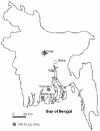Seasonal cholera caused by Vibrio cholerae serogroups O1 and O139 in the coastal aquatic environment of Bangladesh
- PMID: 16751520
- PMCID: PMC1489596
- DOI: 10.1128/AEM.00066-06
Seasonal cholera caused by Vibrio cholerae serogroups O1 and O139 in the coastal aquatic environment of Bangladesh
Abstract
Since Vibrio cholerae O139 first appeared in 1992, both O1 El Tor and O139 have been recognized as the epidemic serogroups, although their geographic distribution, endemicity, and reservoir are not fully understood. To address this lack of information, a study of the epidemiology and ecology of V. cholerae O1 and O139 was carried out in two coastal areas, Bakerganj and Mathbaria, Bangladesh, where cholera occurs seasonally. The results of a biweekly clinical study (January 2004 to May 2005), employing culture methods, and of an ecological study (monthly in Bakerganj and biweekly in Mathbaria from March 2004 to May 2005), employing direct and enrichment culture, colony blot hybridization, and direct fluorescent-antibody methods, showed that cholera is endemic in both Bakerganj and Mathbaria and that V. cholerae O1, O139, and non-O1/non-O139 are autochthonous to the aquatic environment. Although V. cholerae O1 and O139 were isolated from both areas, most noteworthy was the isolation of V. cholerae O139 in March, July, and September 2004 in Mathbaria, where seasonal cholera was clinically linked only to V. cholerae O1. In Mathbaria, V. cholerae O139 emerged as the sole cause of a significant outbreak of cholera in March 2005. V. cholerae O1 reemerged clinically in April 2005 and established dominance over V. cholerae O139, continuing to cause cholera in Mathbaria. In conclusion, the epidemic potential and coastal aquatic reservoir for V. cholerae O139 have been demonstrated. Based on the results of this study, the coastal ecosystem of the Bay of Bengal is concluded to be a significant reservoir for the epidemic serogroups of V. cholerae.
Figures



References
-
- Albert, M. J., A. K. Siddique, M. S. Islam, A. S. G. Faruque, M. Ansaruzzaman, S. M. Faruque, and R. B. Sack. 1993. Large outbreak of clinical cholera due to Vibrio cholerae non-01 in Bangladesh. Lancet 341:704. - PubMed
-
- Cholera Working Group, ICDDR, B. 1993. Large epidemic of cholera-like disease in Bangladesh caused by Vibrio cholerae O139 synonym Bengal. Lancet 342:387-390. - PubMed
-
- Colwell, R. R., and A. Huq. 1994. Vibrios in the environment: viable but non-culturable Vibrio cholerae, p. 117-133. In I. K. Wachsmuth, P. A. Blake, and O. Oslvik (ed.), Vibrio cholerae and cholera: molecular to global perspectives. ASM Press, Washington, D.C.
Publication types
MeSH terms
Grants and funding
LinkOut - more resources
Full Text Sources
Medical
Miscellaneous

